Introduction
Troubleshooting your coffee maker before you've had your cup of coffee can be frustrating. Let's dig into this troubleshooting guide to get your morning cup brewing and start the day off right.
While this guide is focused first on automatic drip coffee makers, a good starting procedure for any device is to follow proper maintenance and cleaning practices — follow this coffee maker cleaning guide and replace old filters. When using soft water, clean your machine with a 1:1 vinegar and water solution every 3 months; when using hard water, clean every month.
When the source of the leak is due to an overflowing or overfilling — where the filter basket overflows — start with the fixes directly below. In the event water is pooling at the base of machine jump to cracked pot.
Causes
Since high temperature tubing in the bottom of the machine could be loose or damaged from movement or heavy use, inspect these hoses for secure connections.
- Remove your bottom plate to access the water lines.
The hoses and their hose clamps can then be removed and visually inspected for disconnections or buildup.
- Clean orifices with a needle or paperclip, and clean insides with soap and water and a small pipe brush.
The warming plate may have melted or otherwise damaged the O-Ring, a rubber ring that lines the connection between the warming plate and the base of the machine. It is supposed to keep water from leaking through the base of the coffeemaker.
- If the seal is in a removable water reservoir, you can replace the reservoir.
- If the seal is built in, you may have to replace the coffee maker





